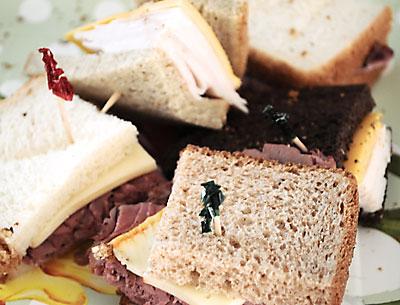Seasons by the Sea: Anything Bread Can Hold

It is said that John Montagu, the fourth Earl of Sandwich, “invented” the sandwich while locked in a 24-hour card game. Nowadays, Gamblers Anonymous would have a field day with this. What, he couldn’t stop gambling long enough to fortify himself? All he did was ask his valet to put meat between two slices of bread so his cards wouldn’t get all greasy. His cronies started ordering “the same as Sandwich,” and hence the name was born. But it could be said that the Jewish sage Hillel the Elder created an earlier version when he wrapped some Paschal lamb with bitter herbs between two pieces of soft matzoh during Passover.
There are so many versions of sandwiches around the world — paninis from Italy, smorrebrod from Scandinavia, croque monsieur from France, banh mi from Vietnam. There are regional versions of submarines, hoagies, heros, and grinders. There is the Philly cheesesteak and muffalettas from New Orleans. If you want to stretch the meaning of any bread with fillings you could include pita wraps, gyros, burritos, and bagels.
One of my favorite sandwiches is the Reuben. Its origins are up for debate. One story, also involving a bunch of gambling men, credits Reuben Kulakofsky of Omaha, Neb. In the 1920s his gang of cronies, nicknamed “the committee,” used to have poker games at the Blackstone Hotel. The owner of the hotel, Charles Schimmel, put the Reuben on the menu and it became nationally famous when one of his employees won a competition with the recipe. Another story credits Arnold Reuben of the now defunct Reuben’s Delicatessen in New York City. Regardless of its origins, it is a perfect combination of salty meats (corned beef, turkey, or pastrami), crunchy vegetables (saurkraut or coleslaw), Thousand Island or Russian dressing, and/or Dijon mustard on good rye bread.
The club sandwich is another delicious classic, a combination of turkey, bacon, lettuce, tomato, and mayo on toasted white bread. This sandwich has been seen on American menus since 1899 and is believed to have originated at, you guessed it, a gambling club in Saratoga Springs, N.Y.
Some sandwiches sound downright dangerous or gross. Remember fluffernutters? Nothing but marshmallow cream and peanut butter on white bread. The chip butty of Sheffield, Yorkshire, is French fries with vinegar or ketchup on bread. In the Baoding Hebei province of China they eat a savory sandwich of shredded donkey. The Danish enjoy a slice of aspic and red onion with salt beef on fat-smeared rye. Another Danish specialty is sal over Gudhjem, an open-faced rye sandwich with smoked herring, chives, and a raw egg yolk.
Remember tea sandwiches? People seldom make them anymore, but they are a charming, dainty tradition for parties. Cucumbers or watercress and finely minced chicken salad or smoked salmon are spread on super thin white or wheat bread. Seasoning, moisture, and restraint are the key ingredients. Crusts cut off, cut into triangles, pinkies in the air when consuming! The trick I learned about tea sandwiches is butter on one slice of bread, mayo on the other. My favorite is a Vidalia onion tea sandwich. Use paper-thin slices of the onion, which is quite sweet and mild. Another good one is made on thin pumpernickel or brown bread spread with a schmear of cream cheese that has been flavored with grated orange zest.
At the other end of the sandwich spectrum are Sloppy Joes and Dagwoods. Sloppy Joes were popular when I was growing up. They are basically a mixture of a barbecuey-tomato sauce and ground hamburger meat on a bun. The Dagwood can be any sandwich piled up ridiculously high with ingredients, made famous by Dagwood Bumstead of the Blondie comic strip. The muffaletta of New Orleans is another huge, thick sandwich made on big round loaves of Italian bread. It contains a wide variety of meats like salami, ham, sopressatta, and cheese. The key ingredient, however, is olive salad, an oily, vinegary mixture of chopped green olives, celery, and garlic.
Another great sandwich that has gained popularity is the banh mi of Vietnam. It is often made with a layer of paté, some roast pork, pickled vegetables, some hot sauce, and mayonnaise. The bread used is key. The Vietnamese version of French bread is lighter and crisper, a bit spongy, like Cuban bread. You don’t want a chewy, dense baguette scraping the roof of your mouth with this sandwich.
A grilled cheese sandwich can be as simple as the child-pleasing American cheese on white bread to the more sophisticated Taleggio with quince paste or cheddar and gouda layered with bacon and tomatoes on Portuguese buns. The French croque monsieur or croque madame is made with a good Gruyere cheese, ham, and a layer of bechamel.
Of course, two of the best sandwiches ever invented are the lobster roll and a plain old tomato sandwich, always only served at the height of summer with a perfect beefsteak tomato, thickly sliced.
You can make a simple sandwich for your children to enjoy, a healthy vegetarian sandwich utilizing hummus, avocadoes, sprouts, and any other vegetables you like on a seven-grain bread, or make one of those belly bombs like a Reuben or Cuban sandwich (roast pork, ham, pickles, cheese, and mustard). Use your imagination! Here are some recipes to inspire you, starting with one of my favorites, the sandwich my father used to make for us on Sunday afternoons.
Click for recipes
